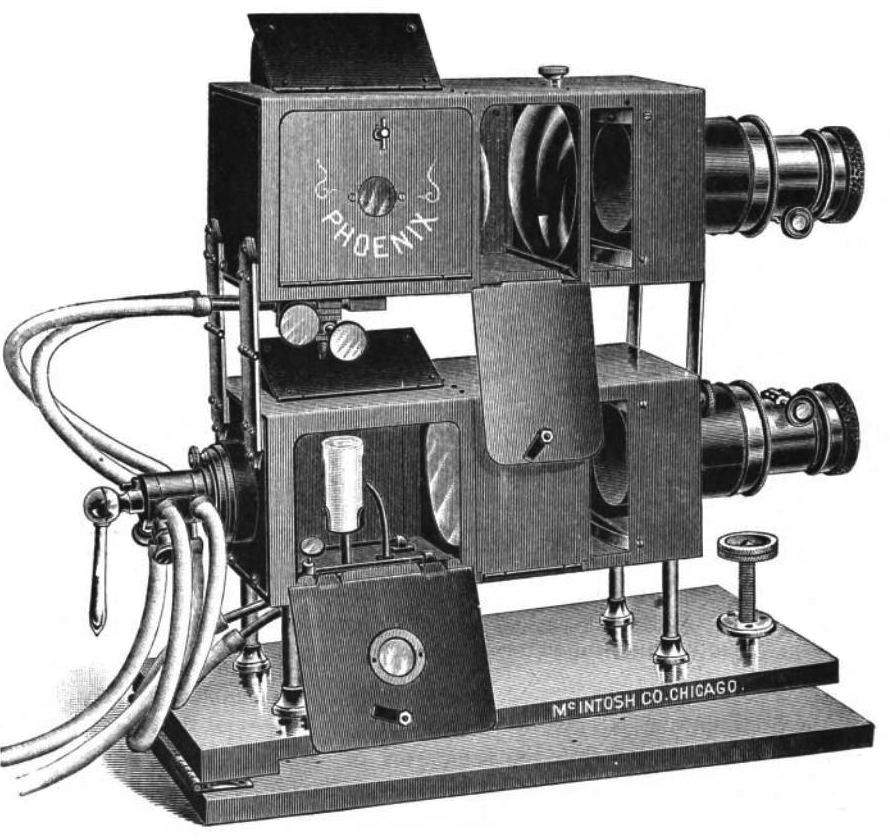Stereopticon on:
[Wikipedia]
[Google]
[Amazon]
 A stereopticon is a
A stereopticon is a
slide projector
A slide projector is an opto-mechanical device for showing photographic slides.
35 mm slide projectors, direct descendants of the larger-format magic lantern, first came into widespread use during the 1950s as a form of occasional home ...
or relatively powerful "magic lantern
The magic lantern, also known by its Latin name , is an early type of image projector that used pictures—paintings, prints, or photographs—on transparent plates (usually made of glass), one or more lenses, and a light source. Because a si ...
", which has two lenses, usually one above the other, and has mainly been used to project photographic images. These devices date back to the mid 19th century, and were a popular form of entertainment and education before the advent of moving pictures.
Magic lanterns originally used rather weak light sources, like candles or oil lamps, that produced projections that were just large and strong enough to entertain small groups of people. During the 19th century stronger light sources, like limelight, became available.
For the "dissolving views
Dissolving views were a popular type of 19th century magic lantern show exhibiting the gradual transition from one projected image to another. The effect is similar to a dissolve in modern filmmaking. Typical examples had landscapes that dissolv ...
" lantern shows that were popularized by Henry Langdon Childe
Henry Langdon Childe (1781–1874) was an English showman, known as a developer of the magic lantern and dissolving views, a precursor of the dissolve in cinematic technique. While the priority question on the technical innovations Childe used i ...
since the late 1830s, lanternists needed to be able to project two aligned pictures in the same spot on a screen, gradually dimming a first picture while revealing a second one. This could be done with two lanterns, but soon biunial lanterns (with two objectives placed one above the other) became common.
William and Frederick Langenheim
Frederick Langenheim (May 5, 1809 – July 16, 1879) was a German-American photographer and pioneer of stereoscopic photography. With his brother, he made the first set of panoramic pictures of Niagara Falls and a sequential set of pictures of ...
from Philadelphia introduced a photographic glass slide technology at the Crystal Palace
Crystal Palace may refer to:
Places Canada
* Crystal Palace Complex (Dieppe), a former amusement park now a shopping complex in Dieppe, New Brunswick
* Crystal Palace Barracks, London, Ontario
* Crystal Palace (Montreal), an exhibition building ...
Exhibition in London in 1851. For circa two centuries magic lanterns had been used to project painted images from glass slides, but the Langenheim brothers seem to have been the firsts to incorporate the relatively new medium of photography
Photography is the art, application, and practice of creating durable images by recording light, either electronically by means of an image sensor, or chemically by means of a light-sensitive material such as photographic film. It is employed ...
(introduced in 1839). To enjoy the details of photographic slides optimally, the stronger lanterns were needed.
By 1860 Massachusetts chemist and businessman John Fallon improved a large biunial lantern, imported from England, and named it ‘stereopticon’.
For a usual fee of ten cents, people could view realistic images of nature, history, and science themes. The two lenses are used to dissolve between images when projected. This "visual storytelling" with technology directly preceded the development of the first moving pictures.
The term stereopticon has been widely misused to name a stereoscope
A stereoscope is a device for viewing a stereoscopic pair of separate images, depicting left-eye and right-eye views of the same scene, as a single three-dimensional image.
A typical stereoscope provides each eye with a lens that makes the ima ...
. The stereopticon has not commonly been used for three-dimensional
Three-dimensional space (also: 3D space, 3-space or, rarely, tri-dimensional space) is a geometric setting in which three values (called ''parameters'') are required to determine the position of an element (i.e., point). This is the informal ...
images.
References
Further reading
*{{cite book , last = Lev , first = Peter , author2=Charles Musser, title = Transforming the Screen, 1950–1959 , publisher =University of California Press
The University of California Press, otherwise known as UC Press, is a publishing house associated with the University of California that engages in academic publishing. It was founded in 1893 to publish scholarly and scientific works by faculty ...
, date = 2003
, isbn = 0-520-08533-7
, display-authors=etal
1850 introductions
Entertainment
Display technology
History of film
American inventions